The Darina Allen Column
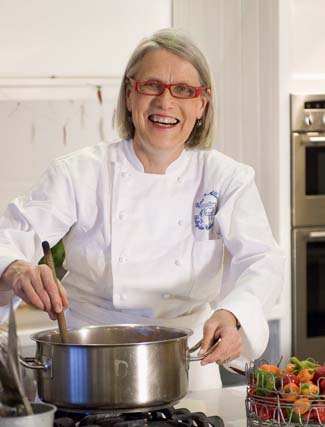 Slow Food has taken me to many remote places around the globe in search of ancient cultures and indigenous foods. On one memorable occasion I found myself in Sápmi (Samiland) in northern Sweden – the land of the midnight sun; it was bright almost all night.
Slow Food has taken me to many remote places around the globe in search of ancient cultures and indigenous foods. On one memorable occasion I found myself in Sápmi (Samiland) in northern Sweden – the land of the midnight sun; it was bright almost all night.
Since time immemorial an indigenous race called the Sami have lived in an area called Sápmi that extends across four countries from the Kola Peninsula in Russia to northern Finland, Norway and Sweden. At present there are about 80,000 Sami whose main occupation is reindeer herding, handicrafts, hunting, fishing and more recently tourism.
Throughout history indigenous people have been oppressed. Their land has been confiscated, their cultures have been suppressed and in some cases they have been victims of genoicide. The Sami have had their share of challenges over the centuries.
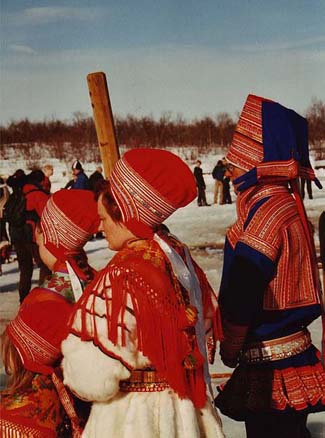 However, in 1993, the Sami government was set up by Act of Parliament. In 1998 the Swedish government apologised to the Sami people for Sweden’s oppression. There are still disputes about ancestral land rights but much progress has been made and in 2010 a representative of the Sami led the procession of indigenous people at the opening of a 2010 Slow Food Terre Madre event in Turin.
However, in 1993, the Sami government was set up by Act of Parliament. In 1998 the Swedish government apologised to the Sami people for Sweden’s oppression. There are still disputes about ancestral land rights but much progress has been made and in 2010 a representative of the Sami led the procession of indigenous people at the opening of a 2010 Slow Food Terre Madre event in Turin.
The Slow food National Councillors meeting was held in Hemavan in Sápmi so we had the opportunity to learn about their food and culture. Like all indigenous tribes they live in harmony with nature. The Sami language is extremely rich; for example, they have over a hundred words for snow.
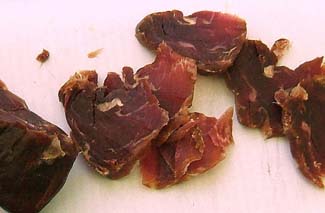 Traditionally their diet consisted of a lot of reindeer and elk meat, fresh, dried, salted and smoked. Every scrap of the deer is utilised as well as the hide for clothing and rugs, the antlers for handicraft and the bones for handles of cutlery, whistles, paper knives…
Traditionally their diet consisted of a lot of reindeer and elk meat, fresh, dried, salted and smoked. Every scrap of the deer is utilised as well as the hide for clothing and rugs, the antlers for handicraft and the bones for handles of cutlery, whistles, paper knives…
In Summer, they eat more fish and vegetables, in late Summer and Autumn, a variety of berries, wild mushrooms and fruit. They bake lots of delicious dry crisp breads before they go up the mountains to herd, it’s stored for months and then dampened and warmed again before they eat it.
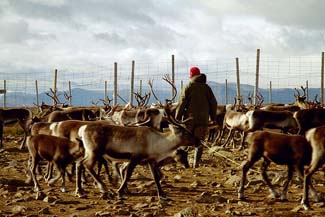 We were invited to a Sami village called Daelvie to see their way of life and beloved reindeer. The entire year of the semi-nomadic Sami revolves around reindeer herding, they follow the deer throughout the seasons – up the mountain slopes in summer and down into the forests in winter. In May they mark the ears of the young ‘calves’ – each family has a distinct mark; September is slaughter month by then the calves are about six months old.
We were invited to a Sami village called Daelvie to see their way of life and beloved reindeer. The entire year of the semi-nomadic Sami revolves around reindeer herding, they follow the deer throughout the seasons – up the mountain slopes in summer and down into the forests in winter. In May they mark the ears of the young ‘calves’ – each family has a distinct mark; September is slaughter month by then the calves are about six months old.
Every scrap of meat is either eaten fresh or preserved and the surplus is sold. Reindeer is some of the purest meat on earth – very high in vitamins, minerals and omega 3 – the animals graze on wild herbs, lichens, grasses, young shoots and bark. The meat is absolutely delicious; we ate it in a myriad of ways, fresh, dried, salted, and smoked, in sausages and burgers, often in conjunction with a wild mushroom sauce.
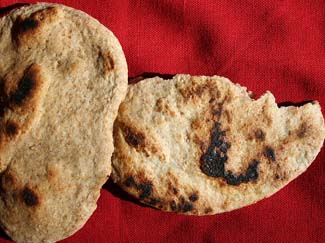 Lingonberries, and other wild berries are used for sauces, preserves and desserts. One evening we had cloudberry jam with waffles and cream. Cloudberies look like yellow raspberries, and grow in mossy areas and in the tundra.
Lingonberries, and other wild berries are used for sauces, preserves and desserts. One evening we had cloudberry jam with waffles and cream. Cloudberies look like yellow raspberries, and grow in mossy areas and in the tundra.
We also ate wild mushrooms in many guises, morels and delicious chantrelles in a soup, little quiches and as a sauce with reindeer and arctic char – the latter is a pink fish with pale flesh not unlike trout. The wild mushrooms are dried during the season and are much loved.
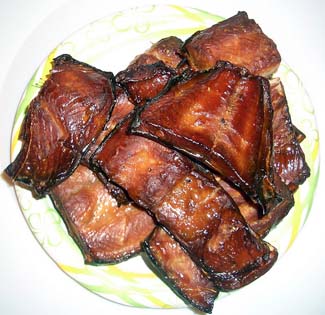 Sami are expert at preserving – in the past their very survival depended on it. Originally they stored food in underground water holes now freezers are more common. In early Spring – they eat the young shoots of rowan and beech and make a soup from spruce leaves and a syrup from the needles. Angelica grows wild; the young stalks are peeled and eaten raw as a vegetable or candied as a sweetmeat.
Sami are expert at preserving – in the past their very survival depended on it. Originally they stored food in underground water holes now freezers are more common. In early Spring – they eat the young shoots of rowan and beech and make a soup from spruce leaves and a syrup from the needles. Angelica grows wild; the young stalks are peeled and eaten raw as a vegetable or candied as a sweetmeat.
They also pick buckets of wild sorrel in early summer and cook it in a little water until it wilts. Then it can be stored for months. They eat it with a blob of whipped cream and some sugar sprinkled on top – this was a revelation – totally delicious full of vitamin C – the oxalic acid is diluted by cream and milk.
The Sami women also explained that the children love to eat bilberry flowers in early June in the mountains. When I walked up the hill I nibbled some, they tasted of sweet honey.
As with many indigenous communities, they know the medicinal value of each plant and food and are passionate about passing on the skills, language, music and traditional dress (gakti) to the younger generation who seem to be hugely proud of their culture and heritage.
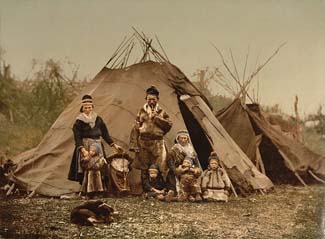 Years ago they lived in simple dwellings called Goahti and Lavvu. The latter was a portable tepee-like hut, the former was a permanent dome shaped structure consisting of a timber frame sealed with birch bark and covered with turf or sods of earth. Nowadays they are more likely to live in a typical Swedish timber house.
Years ago they lived in simple dwellings called Goahti and Lavvu. The latter was a portable tepee-like hut, the former was a permanent dome shaped structure consisting of a timber frame sealed with birch bark and covered with turf or sods of earth. Nowadays they are more likely to live in a typical Swedish timber house.
We had a wonderful feast in the village, of local food from the valley and surrounding area including dried reindeer (Suovasa) a product recognised as unique to the Sami by Slow Food who created a presidia to protect it.
They sang us some of the haunting traditional yoiks, made us coffee in smoked blackened kettles over the open fire and gave us slices of delicious homemade rhubarb Swiss roll.
***
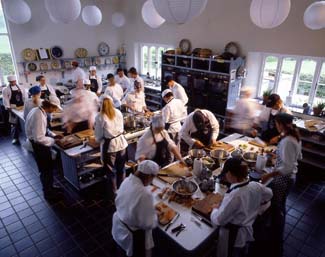 Once again this year, the Ballymaloe Cookery School in East Cork has a great program of cookery courses for all interests and abilities. Ranging from a relaxing visit to sit in on an afternoon cookery demonstration to a week long ‘Intensive Introductory Course’.
Once again this year, the Ballymaloe Cookery School in East Cork has a great program of cookery courses for all interests and abilities. Ranging from a relaxing visit to sit in on an afternoon cookery demonstration to a week long ‘Intensive Introductory Course’.
Sitting in the middle of a 100 acre organic farm the Ballymaloe Cookery School provides its students not only with a life skill learnt under the expert tutelage of their very capable teachers but also a place to relax and unwind from the stresses and strains of normal everyday life. The cottage accommodation available onsite consists of a collection of delightful converted outbuildings which have been transformed over the years by the Allens.
www.cookingisfun.ie





There are currently no comments
Leave a comment
Not a member? Register for your free membership now!
Or leave a comment by logging in with: